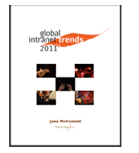My Global Intranet Trends 2011 Highlights
 Jane did it again! Her Global Intranet Trends for 2011 report is out. And it's loaded with all kinds of information about the intranet. Fact and figures, stories and trends. As in previous years I'll pass on some of my highlights from the report. For two reasons: to show you what a great resource this report is, and, to get you to buy it. I think it's worth your money.
Jane did it again! Her Global Intranet Trends for 2011 report is out. And it's loaded with all kinds of information about the intranet. Fact and figures, stories and trends. As in previous years I'll pass on some of my highlights from the report. For two reasons: to show you what a great resource this report is, and, to get you to buy it. I think it's worth your money.There's something strange about the intranet. The intranet has been around for a long time now. Some say the intranet is 'so passé'. Social media is the new intranet. At the same time when I read this report I wonder: if the intranet has been along for so long, how come so few companies get their intranet right? Why isn't it the case that we just copy the great practices of other intranet concepts and technologies to have our own great intranet? Of course I know the answer to at least part of this question. But still, with resources like Jane's survey you should be able to make a very good intranet and move around the pitfalls of others. As I said before, Jane's survey results are a great benchmark for your own intranet. And, they're also a great map if you just started defining your intranet.
Anyway, it seems like we just started with the intranet, like we're just starting to understand and use social media (although it's been around for a while). As Jane mentions in the Preface: the number of conversations about the intranet on LinkedIn, Twitter, etc is still increasing. So, I'll chip in with this post as well!
Now for some highlights from the report.
- This is Jane's 5th report. This year 440 organizations participated in the survey! (That 130 more than last year.) The focus of this year's report is on the leaders in the intranet space. The difference between leaders and the rest is substantial (p. 5). The differences are most defined in the 'people' and 'real-time' dimensions.
- Jane already summarized the intranet megatrends in a post. The intranet is becoming the front-door more and more. Team-orientation is important, largely due to integration of the intranet with tools like Sharepoint. People are more and more important, due to social media in the workplace. Very interesting is the fact that real-time is a trend. The numbers give the proof. And, the last trend, is the intranet becoming accessible from devices and outside the firewall. Jane stresses these trends were already seen in 2009 and are confirmed in last year's and this year's data.
- The previous point is direct input for your intranet strategy. An overarching strategy for the intranet, collaboration and social media is therefore essential (p. 2). I really liked the way the whole report shows how these areas are related and integrate more and more.
- Even though these are the megatrends it doesn't mean we're there yet... Only 10% of the organizations say their entire intranet is collaborative. There's work to do... But 70% of the companies say they use social media of some sort in the organization. (p. 4) Microblogging is the biggest new-entry in the workplace, also showing the need for real-time communication in companies.
- As you would expect social media is a big topic in organizations. The benefits are real (p. 41), although not many (less than 20%) are measuring the value. (Measuring in general is not done much. Only 50% measure the value of their intranet. p. 22) People stress that moderation of social media is needed due to findability, security and language issues. Going from experimentation to enterprise-wide deployment of social media is a big jump (p. 30).
- Interesting statement: "It takes at least 3 to 4 years for social media to become established in a organization." This is something to think about. Organize for the longhaul, said Andy McAfee in his book Enterprise 2.0. This report also gives the data to prove this (p. 42). Don't think social media is an instant success!
- Clearly the report shows social media starts at employee level. To be successful in the long term senior management needs to step up. The data telling us that senior management blogs are highly appreciated, could convince some to step in hopefully. (p. 52) And McKinsey recently showed that companies using social media are market leaders.
- Governance of the intranet is still a big issue. In only 12% of the organizations top management is committed to the intranet. I still find this an amazing fact. How do we get senior managers to see how important it is to support information and communication processes in the right way? How do we get them to see that information and communication is the lifeblood of the organization? On the other hand, their commitment is not a guarantee for success (p. 69). The report does not mention what the guarantee is... ;-) Maybe you know?
- What make the leaders different in this space? They have commitment from top management, social media is well-established in the organization and the intranet is the way of working (it's integrated in their business processes) (p. 11). But only 4 organizations meet all three criteria. 16 meet two out of three criteria. I'm curious if this has to do with the fact that their intranet is more (or less) related to their primary business processes (p. 18 says not many have integration with business applications e.g.). This curiousity increases when I read that 'communication' is the key driver of the intranet. (p. 14) Communication is not a business process...
- There's something strange about the questions and the resulting data about the unified intranet model. The question is whether organizations are moving to a unified intranet. However, relating to the previous point, shouldn't this depend on the type of the organization if they move towards a unified intranet or not. Right? Maybe a fragmented intranet fits perfectly with the way they do business.
- 80% of the companies have a single entry point. And personalization is not popular at all (84% don't have it). (p. 17)
- After reading the numbers on blogging, wiki, video sharing, etc. deployment, I was wondering: having a blog is not the same as actively blogging. It would be nice to hear from the respondents that are blogging, for instance, how many blogs they have and how often they post/comment.
- The section about the benefits of social media is very insightful. (p. 41 and on) I loved the way respondents gave examples of hard and soft benefits. Furthermore the data shows you get more benefits by using social media. I think both points are something that we are learning from new media. Hard benefits aren't the only thing that count in business and IT. And you can only assess it's value by experiencing it. At least this relates well with my experience! :-)
- And a last highlight: The good thing for intranet managers and employees is the respondents say their work will become more and more strategic, due to the importance of social media among others.
In general I really liked this report. The overall structure feels much better (than previous years). The data is presented in nice information packages that we can all use and reuse. The report is long, but it's reads easily and is structured in such a way you can skip over sections (and come back to them when they're relevant).
I hope it's clear this report is not limited to the intranet. It's about the digital workplace in general, about enterprise 2.0, internal/external social media use and in essence about IT organization and implementation. That's why this report is so rich and you should read it. I hope you enjoy it! And after reading it, please share your thoughts with us.
Oh, and if this post doesn't convince you, get the free samples from the report itself here.
Jane, thanks again for this report and all the work you put into it. Hope to see you soon in Utrecht!


